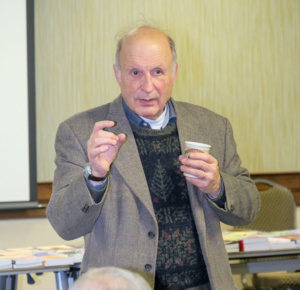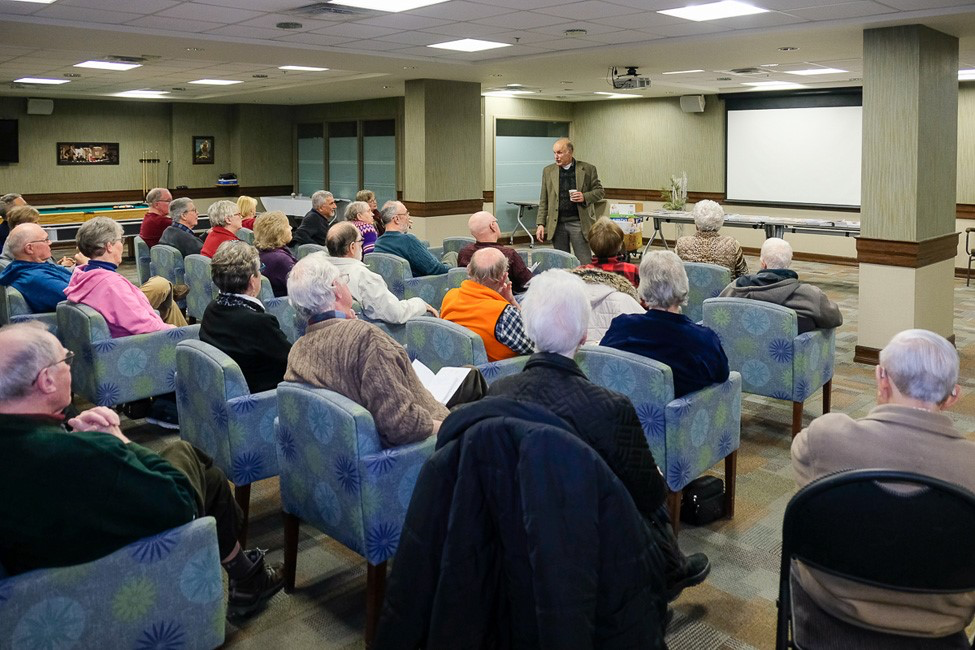The Joys of Canadian History
Presentation by George Laidlaw
Report by Owen Cooke

Some forty members, guests and residents gathered at the Manotick Place for our February meeting. Dorothy Gray introduced our speaker, George Laidlaw, Ottawa born and Manotick raised, and a prolific author.
Mr. Laidlaw spent a career as a federal government biologist, but was always intrigued by Canadian history and story-telling. He has written 91 books, some history, some historical novels, some adult and some aimed at a young adult audience. He brought 75 titles with him to display and for sale. Mr. Laidlaw spoke of his love for history, particularly Canadian history. Canadian history books in schools are boring, he said, but the subject is fascinating.
He took us on a tour through incidents in Canada’s history, mostly military history and presented very much in the “great men” tradition. He began with Wolfe and Montcalm at Québec in 1759. What if Montcalm had waited for his reinforcements to come up from the Beauport shore before giving battle on the Plains of Abraham? It was a failure of Montcalm’s intelligence service which had indicated that Wolfe could bring more men onto the Plains which caused him to attack before they arrived. He did not know that he was facing the totality of Wolfe’s force. In an aside, he also blamed a Canadian militia officer for letting Wolfe’s troops get up the Anse au Foulon to the Plains in the first place.
He repeated the apocryphal tale of Wolfe at Culloden, in which the Duke of Cumberland ordered him to shoot a wounded Highlander, but Wolfe refused, saying he would rather give up his command than shoot a wounded man. From this came the Highlanders’ respect for Wolfe, and the Highland regiments’ service in Canada during the Seven Years War.

Mr. Laidlaw moved on to the War of 1812. He believes that Isaac Brock was a genius, as indicated by the stratagems he employed to convince the American Brigadier General Hull to surrender Detroit, convincing him that the British-Canadian-Indian force was much larger than it was, and implying that he would not be able to control the Indians when battle was joined.
He did, however, criticize Brock for behaving like a junior officer leading his troops personally at Niagara, and getting himself killed. He praised the military skills of Tecumseh, who played such a vital part in the first year of the war and was critical of Major General Henry Procter whose defeat at Moraviantown (the battle of the Thames) led to Tecumseh’s death.
Mr. Laidlaw suggests that Major General William Henry Harrison, “old Tippecanoe”, a future President of the United States, personally killed Tecumseh.
He continued on through Canadian history, with an aside on the Franklin expeditions, in which he repeated the now-discounted story that Franklin’s men died from lead poisoning from the new canning process for foods which he had championed. He discussed the effects of the Fenian raids on Canada, and noted that the final raid on Manitoba in 1871 was foiled by the actions of Louis Riel and a Métis band. This is a less-known contribution by Riel to Canadian history.
The meeting was well attended, the facilities wonderful, the food good and the talk very interesting. A good night.
Mr. Laidlaw’s final segment was the story of the Avro Arrow. In the 1950s A.V. Roe Canada designed and built the Avro CF-105 Arrow, which he claimed to be the most advanced interceptor built then or since. Unfortunately, he said, in 1957, the year the Arrow first flew, the Russians launched Sputnik I, the first orbiting artificial satellite. The Americans lost interest in manned interceptors in favour of missiles and did not encourage the Canadian efforts.
At the same time, he said, Prime Minister John Diefenbaker and A.V. Roe President Crawford Gordon disliked each other intensely. In 1959 Diefenbaker cancelled the Arrow programme and ordered the prototypes to be destroyed. Many Avro employees were in tears. In the years following, many left Canada and joined aerospace development in the United States, some participating in NASA’s programme to put a man on the moon.
A lively question and answer session followed the presentation. Ruth Wright thanked our speaker, and the meeting broke up for refreshments, book buying and more questions to Mr. Laidlaw.
